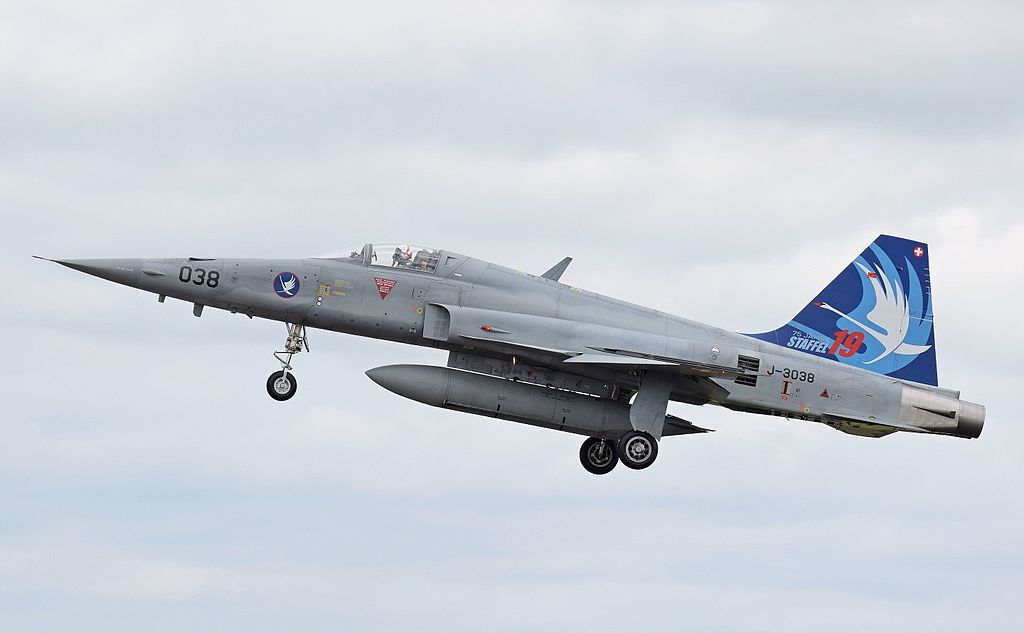The Northrop F-5
One of the most enduring military aircraft designs ever introduced, Northrop ’s F-5 tactical fighter series has served its customers over more than four decades. The F-5’s initial flight was on Jul. 31, 1963, at Edwards Air Force Base, Calif.
The F-5 is an agile, highly maneuverable, reliable supersonic fighter, combining advanced aerodynamic design, engine performance and low operating costs. More than 2,600 were built by Northrop and under co-production and licensing agreements with Canada, the Republic of China, the Republic of Korea, Spain and Switzerland.
From the F-5’s first delivery in 1964 to its final one in 1989, every aircraft was delivered on schedule, at or below the contract price, and with performance as promised. Approximately two-thirds of the original production F-5’s remain operational in 26 countries, including the US. The US Navy operates the F-5 in its adversary squadrons to simulate enemy aircraft in aerial combat training exercises. The US Air Force used the F-5 in a similar training role.
Swiss Air Force F-5 fighter jets
The F-5 is still also used by the Swiss Air Force. The aircraft were purchased by Switzerland because of their excellent performance, suitability for the unique Swiss Air Force mission, and their relatively low maintenance cost per flight hour.
The Tiger is exceptionally sturdy aircraft too as Urs Ramel, F-5 pilot with Swiss Air Force explains in Peter Lewis book Swiss Tiger Parallel Flight:
“Having flown two morning missions during a training session from Dübendorf, I knew that storm-like precipitation and strong turbulence was embedded in an 8’000 meter cloud formation.
“During a lunchtime coffee break, a discussion began on how a lightning strike had penetrated a Tiger’s cockpit and hit the pilot in his thigh just before midday. I had been warned… After an interception mission “on top” at 30’000 feet, we followed a GCA approach in formation through varying cloud densities. While reducing speed before the talk down, we hit strong turbulence and very heavy rain.
F-5 Pilot hit in his thigh by a lightning
“I could hardly make out the outline of my wingman in my mirrors. Just as the first words from the radar operator came in “ten miles long final, gear down”, I felt a heavy blow, as though a hammer hit my left thigh. For a microsecond, I saw a pencil-like vertical streak of lightning in front of me in the cockpit. “Fly the airplane”, I told myself scared, and in the following half a minute it took all my concentration to focus on the instruments to keep within limits. A quick glance around the cockpit confirmed that everything was seemingly OK and when I looked over to my wingman, I was relieved to see that he was still glued to my wingtip as he should be and was nodding his head.
“I reported my status to the operator and we continued the approach without any further issues for a successful landing. My wingman registered his own lightning strike as a hard.. muffled hit, with an impact just above his left eye. Both airplanes had multiple lightning entry and exit points, with rivets that looked like they’d been soldered.
“Right after the flight we were taken to the Air Force Medical Center (FAI) for examination. We both had painful five Franc coin-sized bruises: my wingman’s on his forehead, mine on my thigh. Our bruises may have disappeared within an hour, but that day – March 21, 1986 -has left a mark in both of our memories forever.”
Swiss Tiger Parallel Flight is available to buy here.

Photo by Peng Chen and Myself (Adrian Pingstone) via Wikipedia

